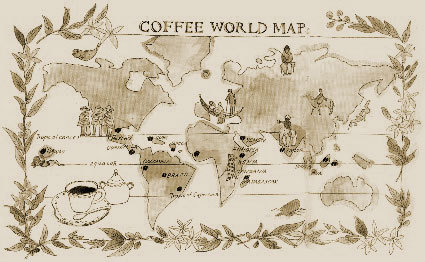The spread of coffee Africa is the hometown of coffee?
People think that Africa is the hometown of coffee. But coffee actually originated in Ethiopia and spread around the world through the Yemeni port of Mocha. The history of Ethiopian coffee cultivation began in 575 AD. For those Arabs, coffee, like Chinese silk at that time, was a national treasure. It would be a great honor if anyone could enjoy this fragrant and refreshing drink, and only a small number of religious people could enjoy this right at that time. In order to prevent coffee from being grown in other countries, Arabs export all coffee beans only after they have been shelled. In the 17th century, BaBa Budan, a pilgrimage to Mecca, brought some sprouting coffee beans back to his home in southwestern India, and coffee began to spread around the world. At first, coffee has been used as a magic drug, limited to doctors' prescriptions. However, its exciting effect was eventually widely used, with many people seeing it as a stimulant to stimulate the brain, while others thought it had the effect of inducing religious hallucinations. As a result, coffee shops are springing up in the center of the Islamic holy city of Mecca. Subsequently, coffee gradually became popular in Italy, India, Britain and other places through trade routes.

Around 1650, the first coffee shop in Western Europe filled with the smell of coffee appeared in Oxford, England. Age of coffee spread: in the early 17th century, Germans, French, Italians and Dutch all competed to sell coffee to their overseas colonies.
In 1616, a coffee tree was transferred to the Netherlands via the port of Mocha, giving the Dutch the upper hand in the competition for coffee cultivation.
In 1658, the Dutch began to grow coffee in Ceylon.
In 1699, the first European plantations appeared in Java by the Dutch.
In 1715, the French brought coffee trees to Bourbon.
In 1718, the Dutch brought coffee to Suriname in South America, which was the prelude to the rapid development of the growing industry in the coffee center of the world (South America).
In 1723, a Frenchman, Gabriel Mathieu de Klee (Gabrie Mathieu De clieu), brought coffee saplings to Martinique.
In 1727, the first plantation in South America, Pala, Brazil, was established. And then cultivated near Rio de Janeiro.
The legendary Jamaican Blue Mountain Coffee began to grow in the Blue Mountains after coffee was introduced to Jamaica by the British in 1730. From 1750 to 1760, coffee was grown in Guatemala.
In 1779, coffee was introduced into Costa Rica from Cuba.
Coffee was first grown in Mexico in 1790.
In 1825, coffee seeds from Rio de Janeiro were brought to the Hawaiian islands and became the famous Hawaiian Kona Coffee.
In 1878, the British landed coffee in Africa and set up a coffee planting park in Kenya.
In 1887, the French established a plantation in Vietnam with coffee saplings.
In 1896, coffee began to land in Queensland, Australia. From then on, the secret of coffee cultivation spread ten, ten hundred, and became an open secret.
Important Notice :
前街咖啡 FrontStreet Coffee has moved to new addredd:
FrontStreet Coffee Address: 315,Donghua East Road,GuangZhou
Tel:020 38364473
- Prev

Coffee culture Arabs eat coffee by chewing the whole fruit.
Do you know? The earliest Arabs ate coffee by chewing the whole fruit to absorb its juice. They then mixed the ground coffee beans with animal fat as a physical supplement for long trips, and it was not until about 1000 AD that the green coffee beans were boiled in boiling water to make an aromatic drink. It took another three centuries for the Arabs to open it.
- Next

Have a cup of coffee with the master, those famous and beloved cafes.
Order a cup of coffee in a quiet cafe and sit down for an afternoon. This is not only a favorite way for modern petty bourgeoisie youth to kill time, but also a source of inspiration for masters. Today, the editor will show you the coffee shop where writers and people used to go. If you have a chance, you can order a cup of coffee and have a conversation across time and space with the masters. Fesavi Cafe (El Fi
Related
- How did the Salvadoran coffee industry develop in Central America?
- What exactly does the golden cup extraction of coffee mean?
- The Origin of Coffee flower
- [2023 Starbucks World Earth Day] there are more meaningful things besides free Starbucks coffee!
- What kind of coffee is there in Spain? 9 Flavors of Spanish Coffee
- Aromatic African coffee| Kenya's coffee culture and historical production area
- Liberica Coffee Bean knowledge: the characteristics of Liberian Coffee beans of the three original species of Coffee beans
- The origin and formula of Spanish latte introduces the taste characteristics of Bombon coffee in Valencia, Spain.
- How to adjust the solution of over-extracted coffee
- What is the tasting period of coffee beans? What is the period of coffee and beans? How should coffee wake up and raise beans?

